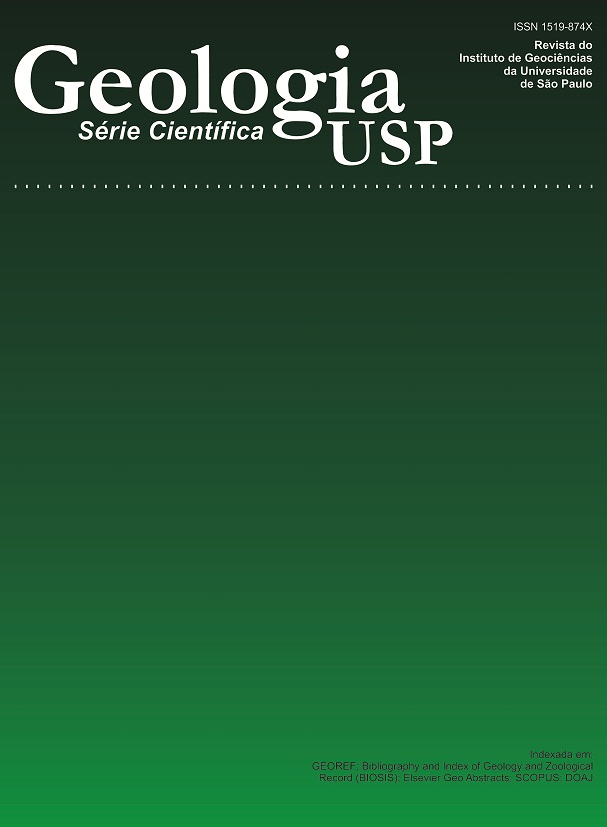Crustal evolution of the western part of the Archean Gavião Block, São Francisco Craton, based on U-Pb, Sm-Nd and Rb-Sr evidence
DOI:
https://doi.org/10.5327/Z1519-874X201300040004Abstract
The western part of the Gavião Block (São Francisco Craton) is one of the oldest fragments of the South American Platform. It comprises the Riacho de Santana Gneissic Migmatitic complex, the Santa Isabel complex and the Riacho de Santana greenstone belt. T DM ages of country rocks of these units reveal that the main accretion periods were: 3.9 Ga, 3.2 - 3.0 Ga and 2.6 Ga. The Gneissic Migmatitic complex yields U-Pb age of 3648 ± 69 Ma, while the negative εNdt value is compatible with crustal reworking. The Rb-Sr isochron provided age of 3247 ± 120 Ma, tentatively interpreted as migmatization event. U-Pb data indicate that crystallization of a rock from the Santa Isabel Complex occurred at 2954 ± 100 Ma ago, with migmatization at 2748 ± 100 Ma ago (Rb-Sr isochron). This complex displays T DM ages of 3.3 - 3.1 Ga and variable εNdt parameters (-4.7 to +0.3), which suggest juvenile and reworking processes from Mesoarchean protholiths with short crustal residence time. Relative the metamafic (tholeiitic) rock from the Riacho de Santana greenstone belt, at least one of the samples indicates anomalous fractionation, yields a 2.6 Ga T DM age whereas the U-Pb crystallization age is 2218 ± 18 Ma. This suggests crustal contamination of the particular mantle source. Shortly after, the country rocks were intruded by the (U/Pb = 2054 ± 8 Ma) Guanambi batholith which was mainly derived from Archean protholiths (T DM ages of 2.8 - 2.7 Ga). Eventually, tectonic and thermal overprints took place in the study area during Meso- and Neoproterozoic periods, as indicated by K-Ar apparent ages and lower intercept age of a U-Pb discordia line from rocks of the Riacho de Santana Gneissic Migmatitic Complex. We believe that these younger episodes reflect the onset of the Northern Espinhaço intracratonic system and the Neoproterozoic dynamics, respectively, as similar as recorded over the Paramirim Corridor.Downloads
Download data is not yet available.
Downloads
Published
2013-12-01
Issue
Section
Articles
License
Authors who publish in this journal shall comply with the following terms:
- Authors keep their copyright and grant to Geologia USP: Série Científica the right of first publication, with the paper under the Creative Commons BY-NC-SA license (summary of the license: https://creativecommons.org/licenses/by-nc-sa/4.0 | full text of the license: https://creativecommons.org/licenses/by-nc-sa/4.0/legalcode) that allows the non-commercial sharing of the paper and granting the proper copyrights of the first publication in this journal.
- Authors are authorized to take additional contracts separately, for non-exclusive distribution of the version of the paper published in this journal (publish in institutional repository or as a book chapter), granting the proper copyrights of first publication in this journal.
- Authors are allowed and encouraged to publish and distribute their paper online (in institutional repositories or their personal page) at any point before or during the editorial process, since this can generate productive changes as well as increase the impact and citation of the published paper (See The effect of Open Access and downloads on citation impact).
How to Cite
Barbosa, N. da S., Teixeira, W., Leal, L. R. B., & Leal, A. B. de M. (2013). Crustal evolution of the western part of the Archean Gavião Block, São Francisco Craton, based on U-Pb, Sm-Nd and Rb-Sr evidence . Geologia USP. Série Científica, 13(4), 63-88. https://doi.org/10.5327/Z1519-874X201300040004





